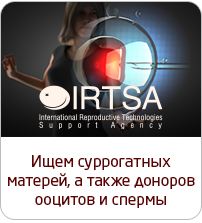Surrogacy
Surrogacy is one of ART methods when a woman (a Surrogate) by her free will and on the terms, fixed by the agreement, gives her consent to undergo implantation of the embryo conceived by means of IVF, and subsequent to carrying and delivering the child genetically unrelated to her in order to relinquish this child to other people (Intended Parents).
This method is in a high demand by those couples who can not overcome infertility by the mean of other ART methods. It is surrogacy which is sometimes the only way to have a child for a woman who has undergone reproductive surgery. For instance, surgical removal of the uterus caused by myoma, bleeding during delivery, etc. Women with deformed uterus or severe diseases preventing from successful pregnancy also fall to think about surrogacy.
In spite of the fact that this method is not the most wide-spread in a reproductive area it is the most popular one. According to some data, at present only several thousand dozens children in the world are born through surrogacy.
Surrogacy is differently regarded even in the countries where it is legal. According to surveys, from 18 to 28% of population (depending on the age and region) consider surrogacy unacceptable.
Surrogacy has the following features:
- mutual arrangements between surrogacy and Intended Parents concerning IVF and embryo transfer into Surrogate’s body;
- fact of child conceiving by IVF and embryo implantation into Surrogate’s uterus;
- genetic link between Intended Parents (or one of them) and a child;
- purposeful carrying of a child by a woman subsequent to relinquishment of this child to Intended parents.
At the moment there are two types of surrogacy:
- traditional;
- gestational.
Traditional surrogacy presupposes biological link between a woman, who carries a child for other couple and the child itself. This type of surrogacy is prohibited in majority of world countries including Ukraine and is classified as child trafficking.
Gestational surrogacy emerged only with advances in ART and infertility therapy. It eliminates the possibility of biological link between a woman who carries a child for other couple and the child itself. A Surrogate carries an embryo of Biological Parents or Intended Parents who do not have biological link with a child (if permitted by law). Moreover, Intended Parents, authorized to use donor gametes (sex cells), oocyte or sperm (or both) according to their medical indications, shall be the parents of the child carried by a Surrogate in anyway.
There are two important features of surrogacy:
The first one is a genetic link between Intended Parents and a child (embryo).
The second one — is a clear arrangement between a Surrogate and Intended Parents to carry a child to the effect to relinquish a child to them after delivery.
There are four ways of surrogacy:
The first one is usage of wife’s oocyte and husband’s sperm. It presupposes a complete genetic link between a child and Intended Parents.
The second one is usage of wife’s oocyte and donor’s sperm. It is a partial genetic link. A child has genetic relationship only to Intended Mother.
The third one is usage of donor’s oocyte and husband’s sperm. It is a partial genetic link. A child has genetic link only with Intended Father.
The fourth one is usage of Surrogate’s egg and husband’s sperm. It is a partial genetic link. A child has genetic link only with Intended Father. This way of surrogacy makes much more serious requirements to a Surrogate, f.i. appearance, no hereditary diseases, etc.









